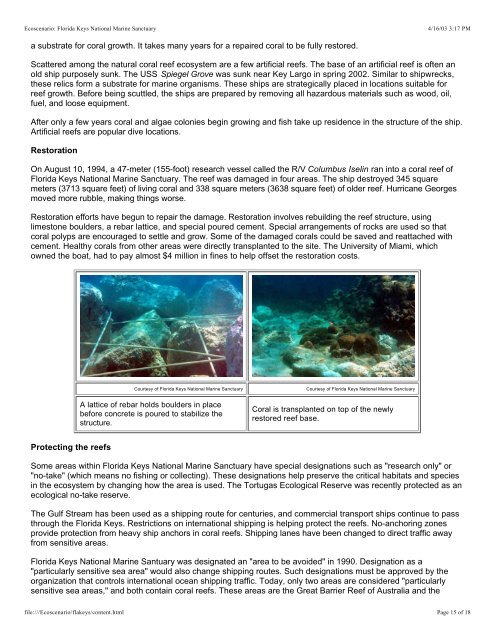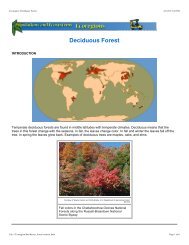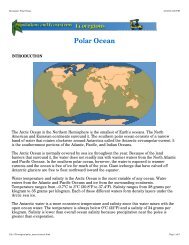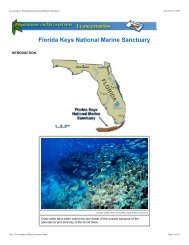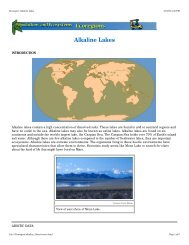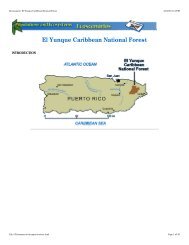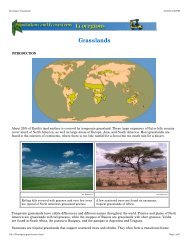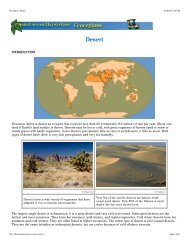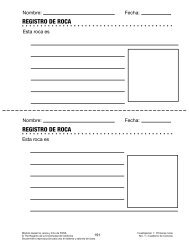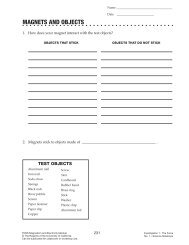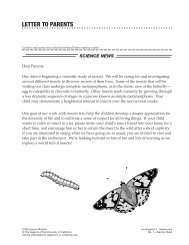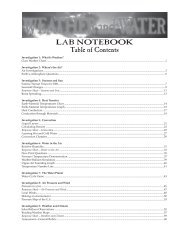Ecoscenarios Combined - FOSSweb
Ecoscenarios Combined - FOSSweb
Ecoscenarios Combined - FOSSweb
You also want an ePaper? Increase the reach of your titles
YUMPU automatically turns print PDFs into web optimized ePapers that Google loves.
Ecoscenario: Florida Keys National Marine Sanctuary<br />
4/16/03 3:17 PM<br />
a substrate for coral growth. It takes many years for a repaired coral to be fully restored.<br />
Scattered among the natural coral reef ecosystem are a few artificial reefs. The base of an artificial reef is often an<br />
old ship purposely sunk. The USS Spiegel Grove was sunk near Key Largo in spring 2002. Similar to shipwrecks,<br />
these relics form a substrate for marine organisms. These ships are strategically placed in locations suitable for<br />
reef growth. Before being scuttled, the ships are prepared by removing all hazardous materials such as wood, oil,<br />
fuel, and loose equipment.<br />
After only a few years coral and algae colonies begin growing and fish take up residence in the structure of the ship.<br />
Artificial reefs are popular dive locations.<br />
Restoration<br />
On August 10, 1994, a 47-meter (155-foot) research vessel called the R/V Columbus Iselin ran into a coral reef of<br />
Florida Keys National Marine Sanctuary. The reef was damaged in four areas. The ship destroyed 345 square<br />
meters (3713 square feet) of living coral and 338 square meters (3638 square feet) of older reef. Hurricane Georges<br />
moved more rubble, making things worse.<br />
Restoration efforts have begun to repair the damage. Restoration involves rebuilding the reef structure, using<br />
limestone boulders, a rebar lattice, and special poured cement. Special arrangements of rocks are used so that<br />
coral polyps are encouraged to settle and grow. Some of the damaged corals could be saved and reattached with<br />
cement. Healthy corals from other areas were directly transplanted to the site. The University of Miami, which<br />
owned the boat, had to pay almost $4 million in fines to help offset the restoration costs.<br />
Courtesy of Florida Keys National Marine Sanctuary<br />
A lattice of rebar holds boulders in place<br />
before concrete is poured to stabilize the<br />
structure.<br />
Courtesy of Florida Keys National Marine Sanctuary<br />
Coral is transplanted on top of the newly<br />
restored reef base.<br />
Protecting the reefs<br />
Some areas within Florida Keys National Marine Sanctuary have special designations such as "research only" or<br />
"no-take" (which means no fishing or collecting). These designations help preserve the critical habitats and species<br />
in the ecosystem by changing how the area is used. The Tortugas Ecological Reserve was recently protected as an<br />
ecological no-take reserve.<br />
The Gulf Stream has been used as a shipping route for centuries, and commercial transport ships continue to pass<br />
through the Florida Keys. Restrictions on international shipping is helping protect the reefs. No-anchoring zones<br />
provide protection from heavy ship anchors in coral reefs. Shipping lanes have been changed to direct traffic away<br />
from sensitive areas.<br />
Florida Keys National Marine Santuary was designated an "area to be avoided" in 1990. Designation as a<br />
"particularly sensitive sea area" would also change shipping routes. Such designations must be approved by the<br />
organization that controls international ocean shipping traffic. Today, only two areas are considered "particularly<br />
sensitive sea areas," and both contain coral reefs. These areas are the Great Barrier Reef of Australia and the<br />
file:///Ecoscenario/flakeys/content.html<br />
Page 15 of 18


